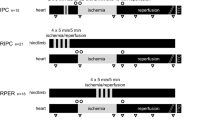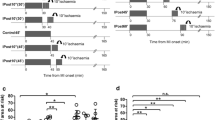Abstract
Postconditioning in the early reperfusion period confers protection to the heart after a potentially lethal episode of prolonged ischemia. Protection from this novel intervention has been documented in rat, rabbit and canine hearts, but one group has reported that it is ineffective in pigs, a large-animal species that should be most relevant to humans. We hypothesized that this negative result was related to an inappropriate postconditioning protocol rather than the species. The present study, therefore, tested whether an effective postconditioning protocol could be identified that limits infarct size in anesthetized pigs. Domestic Landrace pigs weighing 25–29 kg were anesthetized, and after a mid-sternal thoracotomy and pericardiotomy the left anterior descending coronary artery was ligated for 60 min followed by 3 h of reperfusion. Three groups were studied: control group (n = 5) with no other intervention, 4–30 PostC group (n = 5) with 4 cycles of 30-s reperfusion/30-s ischemia, and 8–30 PostC group (n = 6) with 8 cycles of 30-s reperfusion/30-s ischemia. The two postconditioning protocols started immediately after termination of the 60-min coronary occlusion. Region at risk and infarct size were delineated with the aid of pre-mortem monastral blue injection and postmortem staining with triphenyltetrazolium chloride, respectively. In control hearts 33.5 ± 7.6% of the risk zone infarcted and 36.7 ± 3.7% in the 4–30 PostC group (P = NS). But there was only 10.5 ± 0.5% infarction in the 8–30 PostC group (P < 0.01 vs. the other two groups). Postconditioning confers protection in pigs but requires more than 4 ischemia/reperfusion cycles. Postconditioning may protect by inhibiting mitochondrial permeability transition pore formation by keeping the heart acidotic as it is reoxygenated. If true, then it would be difficult to employ too many occlusion cycles.
Similar content being viewed by others
References
Argaud L, Gateau-Roesch O, Chalabreysse L, Gomez L, Loufouat J, Thivolet-Béjui F, Robert D, Ovize M (2004) Preconditioning delays Ca2+-induced mitochondrial permeability transition. Cardiovasc Res 61:115–122
Argaud L, Gateau-Roesch O, Raisky O, Loufouat J, Robert D, Ovize M (2005) Postconditioning inhibits mitochondrial permeability transition. Circulation 111:194–197
Cohen MV, Yang X-M, Downey JM (1994) Conscious rabbits become tolerant to multiple episodes of ischemic preconditioning. Circ Res 74:998–1004
Darling CE, Jiang R, Maynard M, Whittaker P, Vinten-Johansen J, Przyklenk K (2005) Postconditioning via stuttering reperfusion limits myocardial infarct size in rabbit hearts: role of ERK1/2. Am J Physiol 289:H1618–H1626
Downey JM, Cohen MV (2006) A really radical observation–a comment on Penna et al. in Basic Res Cardiol (2006) 101:180–189. Basic Res Cardiol 101:190–191
Hausenloy DJ,Maddock HL, Baxter GF, Yellon DM (2002) Inhibiting mitochondrial permeability transition pore opening: a new paradigm for myocardial preconditioning? Cardiovasc Res 55:534–543
Hausenloy DJ, Yellon DM, Mani-Babu S, Duchen MR (2004) Preconditioning protects by inhibiting the mitochondrial permeability transition. Am J Physiol 287:H841–H849
Heusch G (2004) Postconditioning: old wine in a new bottle? J Am Coll Cardiol 44:1111–1112
Iliodromitis EK, Kremastinos DT, Katritsis DG, Papadopoulos CC, Hearse DJ (1997) Mutliple cycles of preconditioning cause loss of protection in open-chest rabbits. J Mol Cell Cardiol 29:915–920
Iliodromitis EK, Zoga A, Vrettou A, Andreadou I, Paraskevaidis IA, Kaklamanis L, Kremastinos DT (2006) The effectiveness of postconditioniing and preconditioning on infarct size in hypercholesterolemic and normal anesthetized rabbits. Atherosclerosis (in press)
Kin H, Zatta AJ, Lofye MT,Amerson BS, Halkos ME, Kerendi F, Zhao Z-Q, Guyton RA, Headrick JP, Vinten-Johansen J (2005) Postconditioning reduces infarct size via adenosine receptor activation by endogenous adenosine. Cardiovasc Res 67:124–133
Kin H, Zhao Z-Q, Sun H-Y, Wang N-P, Corvera JS, Halkos ME, Kerendi F, Guyton RA, Vinten-Johansen J (2004) Postconditioning attenuates myocardial ischemia-reperfusion injury by inhibiting events in the early minutes of reperfusion. Cardiovasc Res 62:74–85
Li GC, Vasquez JA, Gallagher KP, Lucchesi BR (1990) Myocardial protection with preconditioning. Circulation 82:609–619
Philipp S, Downey JM, Cohen MV (2004) Postconditioning must be initiated in less than 1 minute following reperfusion and is dependent on adenosine receptors and PI3-kinase. Circulation 110 (Suppl III):III-168 (Abstract)
Philipp S, Yang X-M, Cui L, Davis AM, Downey JM, Cohen MV (2006) Postconditioning protects rabbit hearts through a protein kinase C-adenosine A2b receptor cascade. Cardiovasc Res 70:308–314
Schwartz LM, Lagranha CJ (2006) Ischemic postconditioning during reperfusion activates Akt and ERK without protecting against lethal myocardial ischemia-reperfusion injury in pigs. Am J Physiol 290:H1011–H1018
Staat P, Rioufol G, Piot C, Cottin Y, Cung TT, L’Huillier I, Aupetit J-F, Bonnefoy E, Finet G, André-Fouët X, Ovize M (2005) Postconditioning the human heart. Circulation 112:2143–2148
Tsang A, Hausenloy DJ, Mocanu MM, Yellon DM (2004) Postconditioning: a form of “modified reperfusion” protects the myocardium by activating the phosphatidylinositol 3-kinase-Akt pathway. Circ Res 95:230–232
Yang X-M, Philipp S, Downey JM, Cohen MV (2005) Postconditioning’s protection is not dependent on circulating blood factors or cells but involves adenosine receptors and requires PI3-kinase and guanylyl cyclase activation. Basic Res Cardiol 100:57–63
Yang X-M, Proctor JB, Cui L, Krieg T, Downey JM, Cohen MV (2004) Multiple, brief coronary occlusions during early reperfusion protect rabbit hearts by targeting cell signaling pathways. J Am Coll Cardiol 44:1103–1110
Zhao Z-Q, Corvera JS, Halkos ME, Kerendi F, Wang N-P, Guyton RA, Vinten-Johansen J (2003) Inhibition of myocardial injury by ischemic postconditioning during reperfusion: comparison with ischemic preconditioning. Am J Physiol 285:H579–H588
Author information
Authors and Affiliations
Corresponding author
Rights and permissions
About this article
Cite this article
Iliodromitis, E.K., Georgiadis, M., Cohen, M.V. et al. Protection from postconditioning depends on the number of short ischemic insults in anesthetized pigs. Basic Res Cardiol 101, 502–507 (2006). https://doi.org/10.1007/s00395-006-0606-3
Received:
Revised:
Accepted:
Published:
Issue Date:
DOI: https://doi.org/10.1007/s00395-006-0606-3




